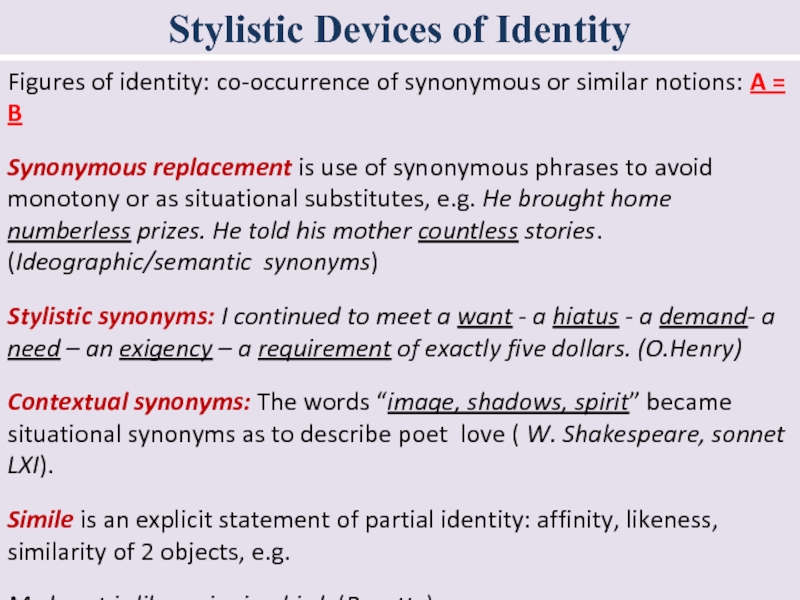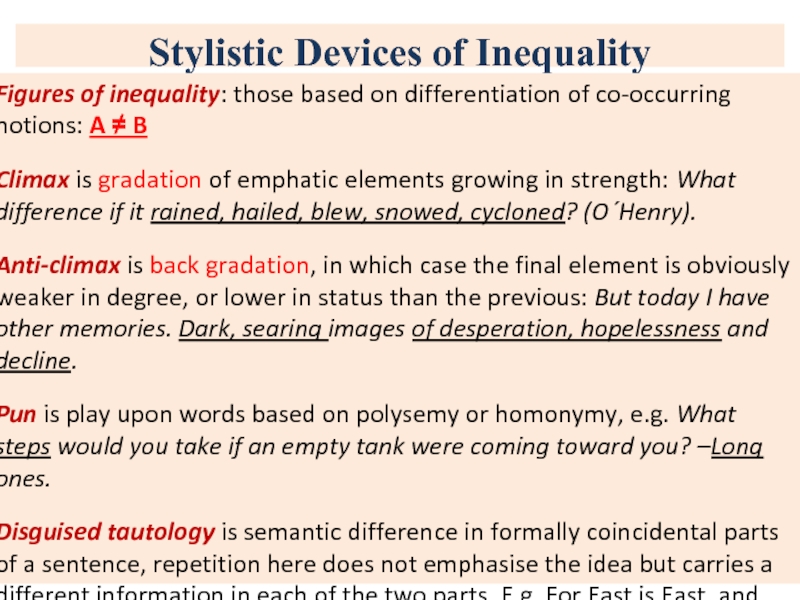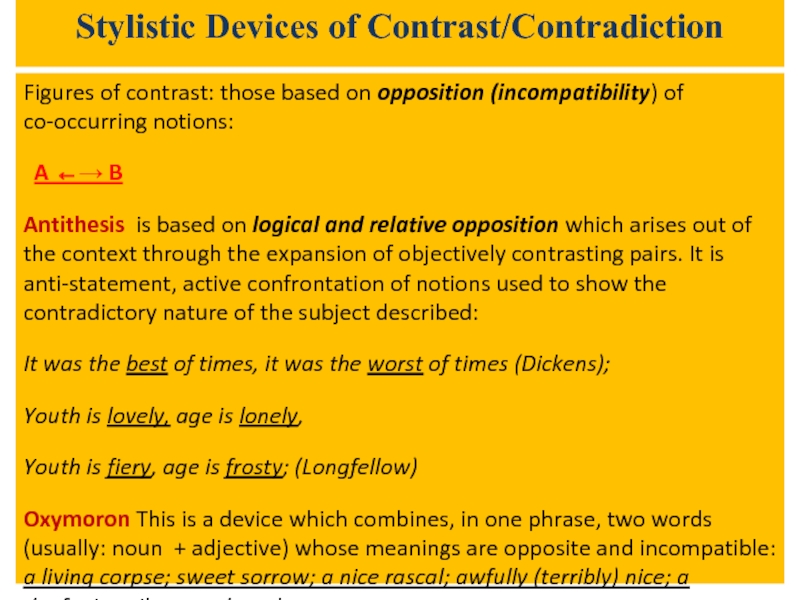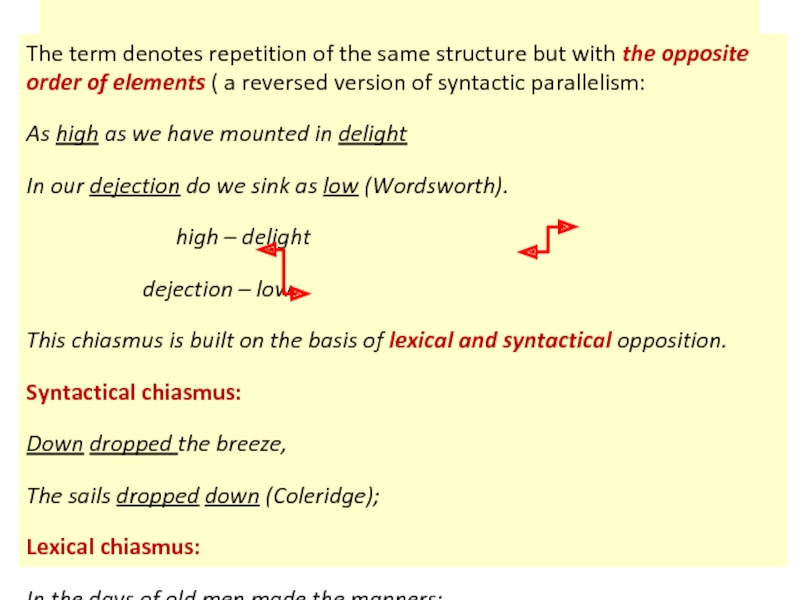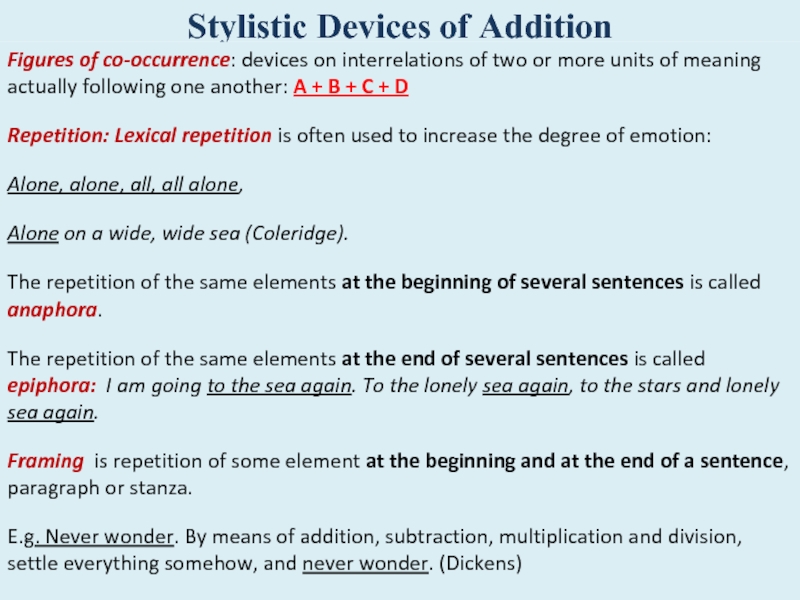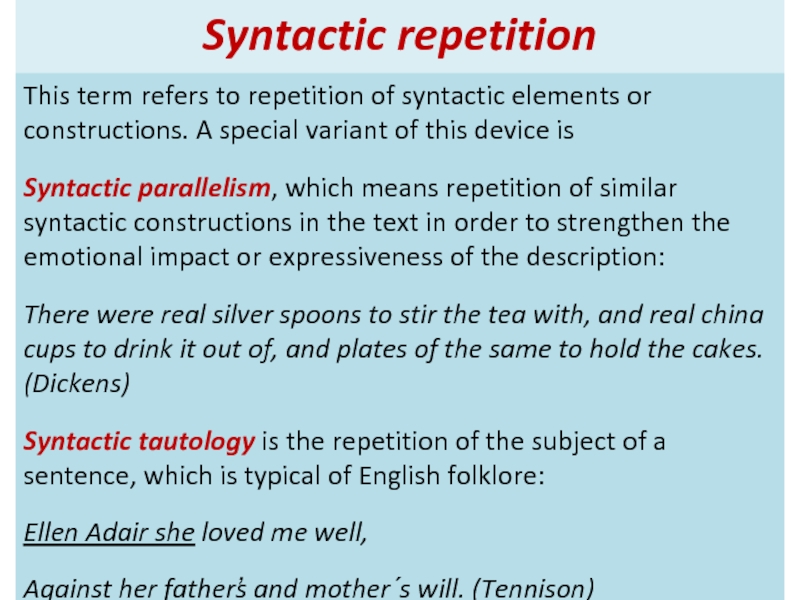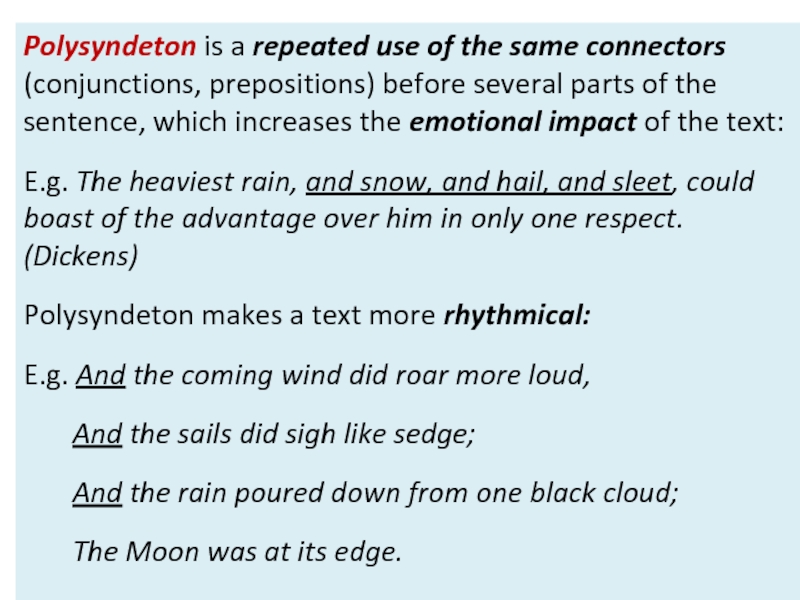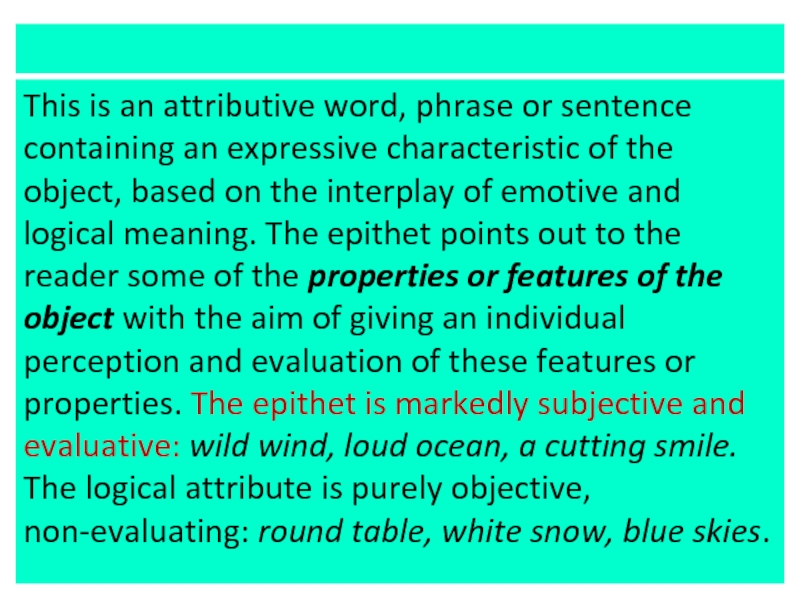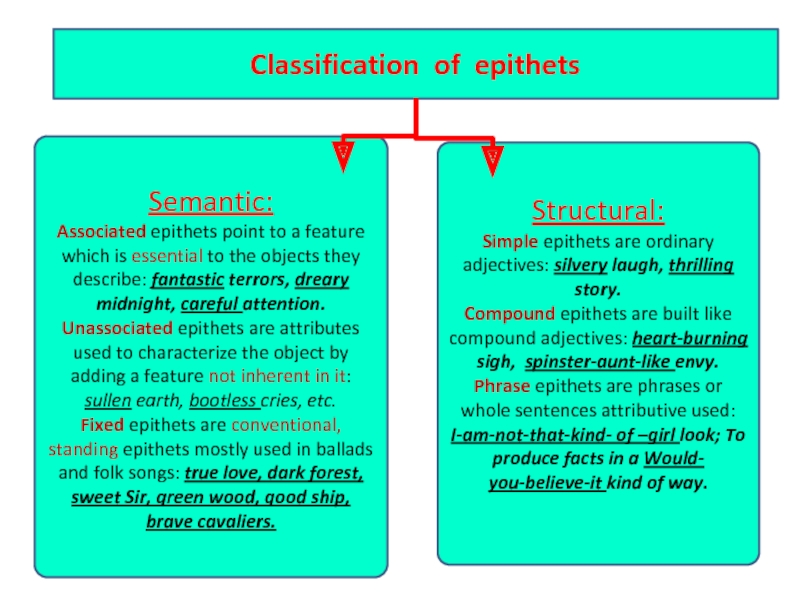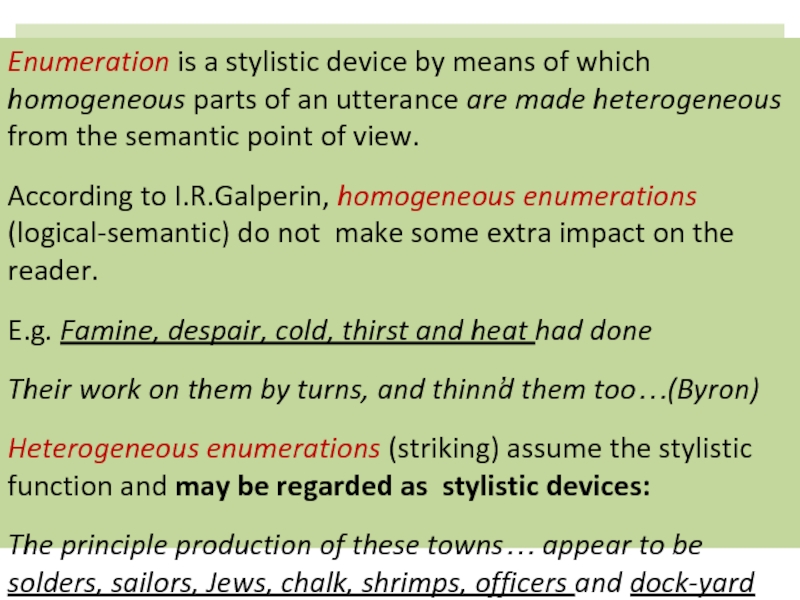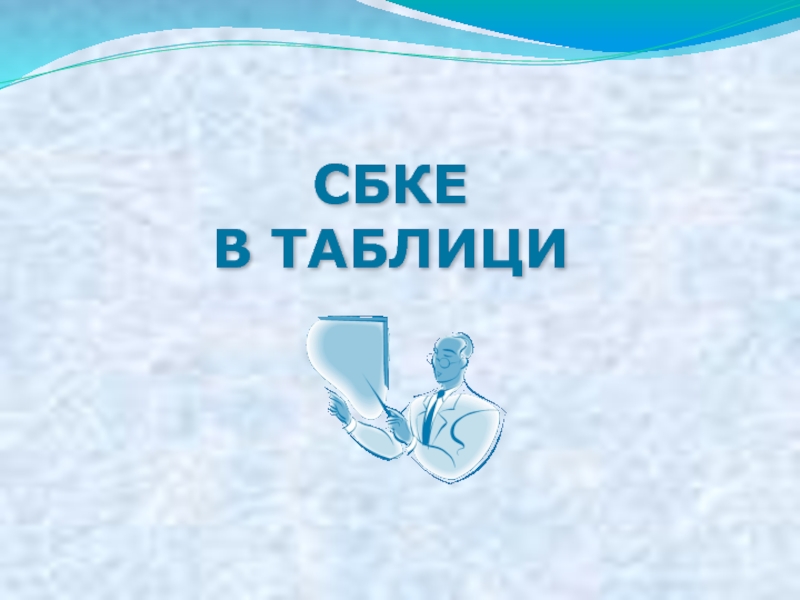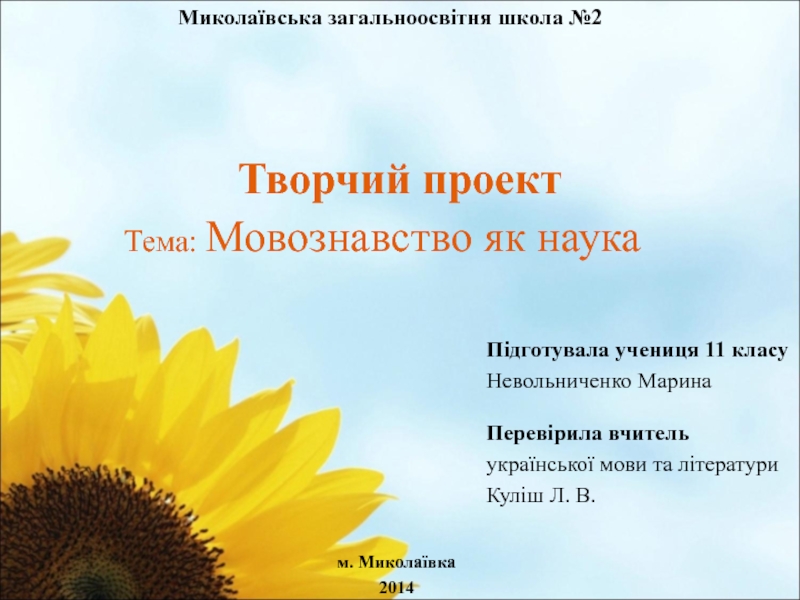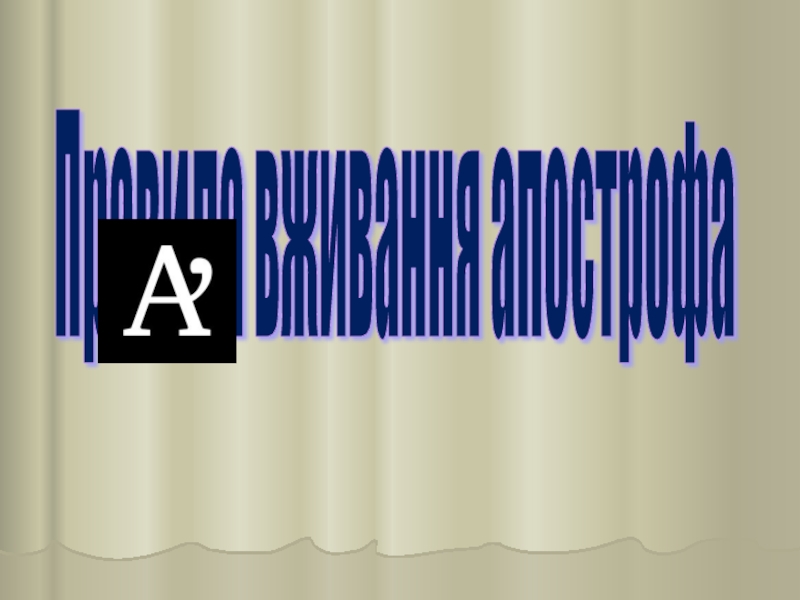- Главная
- Разное
- Дизайн
- Бизнес и предпринимательство
- Аналитика
- Образование
- Развлечения
- Красота и здоровье
- Финансы
- Государство
- Путешествия
- Спорт
- Недвижимость
- Армия
- Графика
- Культурология
- Еда и кулинария
- Лингвистика
- Английский язык
- Астрономия
- Алгебра
- Биология
- География
- Детские презентации
- Информатика
- История
- Литература
- Маркетинг
- Математика
- Медицина
- Менеджмент
- Музыка
- МХК
- Немецкий язык
- ОБЖ
- Обществознание
- Окружающий мир
- Педагогика
- Русский язык
- Технология
- Физика
- Философия
- Химия
- Шаблоны, картинки для презентаций
- Экология
- Экономика
- Юриспруденция
Stylistic Devices of Identity презентация
Содержание
- 1. Stylistic Devices of Identity
- 2. Stylistic Devices of Inequality Figures of inequality:
- 3. Stylistic Devices of Contrast/Contradiction Figures of contrast:
- 4. Chiasmus The term denotes repetition
- 5. Stylistic Devices of Addition Figures of co-occurrence:
- 6. Syntactic repetition This term refers to repetition
- 7. Polysyndeton is a repeated use of
- 8. Epithet This is an attributive
- 9. Classification of epithets Semantic: Associated epithets point
- 10. Enumeration Enumeration is a stylistic
Слайд 1Stylistic Devices of Identity
Figures of identity: co-occurrence of synonymous or similar
Synonymous replacement is use of synonymous phrases to avoid monotony or as situational substitutes, e.g. He brought home numberless prizes. He told his mother countless stories. (Ideographic/semantic synonyms)
Stylistic synonyms: I continued to meet a want - a hiatus - a demand- a need – an exigency – a requirement of exactly five dollars. (O.Henry)
Contextual synonyms: The words “image, shadows, spirit” became situational synonyms as to describe poet love ( W. Shakespeare, sonnet LXI).
Simile is an explicit statement of partial identity: affinity, likeness, similarity of 2 objects, e.g.
My heart is like a singing bird. (Rosetty)
Слайд 2Stylistic Devices of Inequality
Figures of inequality: those based on differentiation of
Climax is gradation of emphatic elements growing in strength: What difference if it rained, hailed, blew, snowed, cycloned? (O΄Henry).
Anti-climax is back gradation, in which case the final element is obviously weaker in degree, or lower in status than the previous: But today I have other memories. Dark, searing images of desperation, hopelessness and decline.
Pun is play upon words based on polysemy or homonymy, e.g. What steps would you take if an empty tank were coming toward you? –Long ones.
Disguised tautology is semantic difference in formally coincidental parts of a sentence, repetition here does not emphasise the idea but carries a different information in each of the two parts. E.g. For East is East, and West is West…(Kipling)
Слайд 3Stylistic Devices of Contrast/Contradiction
Figures of contrast: those based on opposition (incompatibility)
A ←→ B
Antithesis is based on logical and relative opposition which arises out of the context through the expansion of objectively contrasting pairs. It is anti-statement, active confrontation of notions used to show the contradictory nature of the subject described:
It was the best of times, it was the worst of times (Dickens);
Youth is lovely, age is lonely,
Youth is fiery, age is frosty; (Longfellow)
Oxymoron This is a device which combines, in one phrase, two words (usually: noun + adjective) whose meanings are opposite and incompatible: a living corpse; sweet sorrow; a nice rascal; awfully (terribly) nice; a deafening silence; a low skyscraper.
Слайд 4
Chiasmus
The term denotes repetition of the same structure but with the
As high as we have mounted in delight
In our dejection do we sink as low (Wordsworth).
high – delight
dejection – low
This chiasmus is built on the basis of lexical and syntactical opposition.
Syntactical chiasmus:
Down dropped the breeze,
The sails dropped down (Coleridge);
Lexical chiasmus:
In the days of old men made the manners;
Manners now make men (Byron)
Слайд 5Stylistic Devices of Addition
Figures of co-occurrence: devices on interrelations of two
Repetition: Lexical repetition is often used to increase the degree of emotion:
Alone, alone, all, all alone,
Alone on a wide, wide sea (Coleridge).
The repetition of the same elements at the beginning of several sentences is called anaphora.
The repetition of the same elements at the end of several sentences is called epiphora: I am going to the sea again. To the lonely sea again, to the stars and lonely sea again.
Framing is repetition of some element at the beginning and at the end of a sentence, paragraph or stanza.
E.g. Never wonder. By means of addition, subtraction, multiplication and division, settle everything somehow, and never wonder. (Dickens)
Anadiplosis –the final element of one sentence, paragraph, stanza is repeated in the initial part of the next sentence, paragraph, stanza.
E.g. Three fishers went sailing out into the West.
Out into the West, as the sun went down. (Kingsley)
Слайд 6Syntactic repetition
This term refers to repetition of syntactic elements or constructions.
Syntactic parallelism, which means repetition of similar syntactic constructions in the text in order to strengthen the emotional impact or expressiveness of the description:
There were real silver spoons to stir the tea with, and real china cups to drink it out of, and plates of the same to hold the cakes. (Dickens)
Syntactic tautology is the repetition of the subject of a sentence, which is typical of English folklore:
Ellen Adair she loved me well,
Against her father̕s and mother΄s will. (Tennison)
Слайд 7
Polysyndeton is a repeated use of the same connectors (conjunctions, prepositions)
E.g. The heaviest rain, and snow, and hail, and sleet, could boast of the advantage over him in only one respect. (Dickens)
Polysyndeton makes a text more rhythmical:
E.g. And the coming wind did roar more loud,
And the sails did sigh like sedge;
And the rain poured down from one black cloud;
The Moon was at its edge.
Слайд 8
Epithet
This is an attributive word, phrase or sentence containing an expressive
Слайд 9Classification of epithets
Semantic:
Associated epithets point to a feature which is essential
Unassociated epithets are attributes used to characterize the object by adding a feature not inherent in it: sullen earth, bootless cries, etc.
Fixed epithets are conventional, standing epithets mostly used in ballads and folk songs: true love, dark forest, sweet Sir, green wood, good ship, brave cavaliers.
Structural:
Simple epithets are ordinary adjectives: silvery laugh, thrilling story.
Compound epithets are built like compound adjectives: heart-burning sigh, spinster-aunt-like envy.
Phrase epithets are phrases or whole sentences attributive used: I-am-not-that-kind- of –girl look; To produce facts in a Would- you-believe-it kind of way.
Слайд 10
Enumeration
Enumeration is a stylistic device by means of which homogeneous parts
According to I.R.Galperin, homogeneous enumerations (logical-semantic) do not make some extra impact on the reader.
E.g. Famine, despair, cold, thirst and heat had done
Their work on them by turns, and thinn̕d them too…(Byron)
Heterogeneous enumerations (striking) assume the stylistic function and may be regarded as stylistic devices:
The principle production of these towns… appear to be solders, sailors, Jews, chalk, shrimps, officers and dock-yard men. (Dickens)
